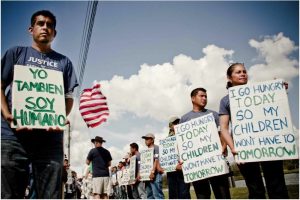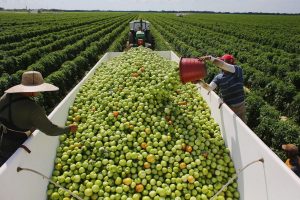Key Aims & Messages
The primary aim of Food Chains was to address the low wages being paid to farmworkers despite their incredible efforts. The issue was confronted by mentioning the history of farmworkers, the progression of their rights, and current efforts to create resolutions to improve conditions. The film ends on a positive note, stating that over 90% of the tomato farms in Florida are now covered by the Fair Food Program, and that industry giants such as Taco Bell, Walmart, Burger King, and Whole Foods back the agreement. Walmart has gone as far as to extend the program to other crops in the United States, exemplifying an extraordinary effort to fight for farmworkers’ rights.
Ideologies
Throughout the film, fair wages for quality work, fighting for what is right, and protecting those who cannot protect themselves were the key ideologies that underlie…. The fight for fair wages was exemplified throughout the entire film in the form of protests, agreements between retailers and farmworkers, and historical references. The fight for justice references the sexual harassment of female farmworkers as well as the enslavement of farmworkers who could not seek help. Many references to this struggle are made throughout the film, with the director citing court cases and statistics, with justice coming in the form of the Fair Food Program that “eliminates slavery in those fields and empowers women to report sexual harassment. The defense of those who cannot defend themselves is an ideology that references the struggle that undocumented farm workers face. Their undocumented status makes migrant individuals largely vulnerable to abuse and neglect by industry giants due to the fact that they cannot seek legal protection without risking deportation.

Key Storylines
The key storylines that were used to develop and support the primary aim of the documentary and ideologies involved the portrayal of the Immokalee farm workers’ lives and working conditions in Florida. The film shows them living in small trailers with up to 15 people, while only making an average of $40 a day. One particular family was shown taking their child to the babysitter around 5 a.m., and shared that they wouldn’t return to pick them up until 8 p.m. A clip of Martin Luther King Jr saying “Plantations were created by those who have power to confine those who do not have power” was included to emphasize the reason behind the workers’ low wages and poor living conditions (7:06). The workers are placing the blame on supermarkets, such as Publix, who are refusing to pay the farmers one extra penny per tomato, which would double the workers’ wages (10:45). Over the last 3 decades, production costs for farmers have increased; however, supermarkets insisted that the farmers keep the same cost, which dramatically cut into their profits (21:08). The workers are shown standing up for what they believe in as they launch a hunger strike outside of the Publix headquarters, with signs reading “I go hungry today so my children won’t have to tomorrow” and “You are human, so am I” (14:02). The use of the strike story line allows for the portrayal of the ideologies of fair wages for quality work and a sense of equal human rights.

Linkages to Class
There are several linkages throughout the film that connect to concepts we have discussed in class. Agriculture is seen all throughout the film since the farm workers are the main focus of it, as well as the physical environment of the biocultural model. The idea of food systems is also referred to, with the farm workers contributing to the production of the tomatoes, as well as the distribution of them to the supermarkets. The issue of food systems both reflecting and shaping social inequality is clearly present in the film. The household income of the farm workers does not allow for them to have the adequate amount of food needed. Because the workers are only earning around a penny per pound of tomatoes they harvest, they are “living day to day and sometimes don’t even eat” (28:02). Lastly, issues in the film are being framed as other things, such as the obesity issue we talked about in class being classified as an epidemic. In the documentary, the worker’s conditions are being framed as immigration issues, rather than human rights issues falling on the supermarkets and fast food institutions.
Opinions
David – The 2014 documentary, Food Chains, does an excellent job portraying the struggle that undocumented farmworkers face in their struggle for fair pay and equal legal protections. The director does an excellent job building empathy for the workers with his utilization of speakers, movement leaders, and real farm workers. Additionally, the expert use of historical references and clips allows the audience to understand just how long migrant workers have been fighting for equal pay and protections. This is a major upside to the film considering many documentaries fall short in this realm. However, one area where the film falls short is in offering the opinions of the big industries in which they criticize so heavily. While the film argues virtuous points, at the end of the day both sides of the argument are not presented and falls short in that regard. Furthermore, the film builds their entire storyline on the tomato industry but seemingly passes over other crops which somewhat takes away from the film in the sense that other violations of rights are likely occurring elsewhere. Overall, the film constructs a solid argument in defense of migrant farm workers who are employed in the tomato industry, but fails to acknowledge other industries sufficiently as well as failing to allow a rebuttal from industry giants.
Alex – The documentary Food Chains was overall successful in portraying the living and working conditions of the Immokalee farm workers, as well as explaining the issues that occur within the supermarket industry. The film was able to appeal to the emotions of the viewers while presenting the poor conditions and poverty the farm workers encounter daily. By showing them working out on the fields in the Florida heat, the producers were able to show how much the workers go through for such little money in return. They were also able to illustrate how the supply chain works through the use of simple clip art graphics, making it easy to understand the way the supermarket industry causes these issues. Lastly, implementing the Martin Luther King clip (7:06) defined the origin of slaves, and the Harvest of Shame clip (14:26) showed that not much as changed in Immokalee, Florida since 1960. These outside clips allow for a better understanding of where these problems originated, and just how long they have been going on. Although there weren’t many weaknesses in this film, one appeared, as it was very one-sided in terms of viewpoints. The viewpoints of the supermarkets were not addressed, and they weren’t able to provide their reasonings, even if these reasons were not sufficient. In the end, this was an eye opening documentary, since “most people have no idea that they are connected to this system every time they buy fresh vegetables” (8:05), as they are unaware of what goes on behind the scenes with food production.
References
Binged.com (2021). [Untitled illustration of Food Chains image]. Retrieved March 18, 2021 from https://www.binged.com/streaming-premiere-dates/food-chains-movie-streaming-online-watch-on-tubi/
Keshari, S. (Producer), & Rawal, S. (Director). (2014). Food Chains [Motion Picture]. United States: Screen Media
National Geographic (2015). [Workers protest and stage a hunger strike outside a Publix in 2012.] Retrieved March 21, 2021 from https://www.nationalgeographic.com/culture/article/tomato-pickers-expand-case-for-workers-rights
Raedle, Joe (2017). [Workers fill a trailer with tomatoes on Tony DiMare’s farm in Florida City, Fla.] Retrieved March 21, 2021 from https://www.washingtonpost.com/business/economy/how-a-group-of-florida-tomato-growers-could-help-derail-nafta/2017/10/16/e1ec5438-b27c-11e7-a908-a3470754bbb9_story.html